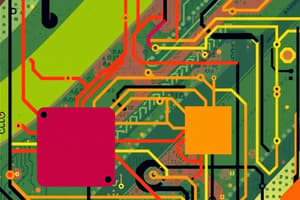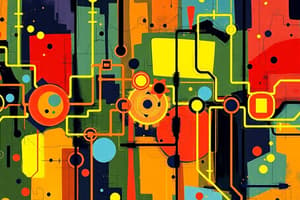Podcast
Questions and Answers
التيار الكهربائي قد ينشق ويتحد مرة أخرى في الدوائر الكهربائية المعقدة؟
التيار الكهربائي قد ينشق ويتحد مرة أخرى في الدوائر الكهربائية المعقدة؟
False (B)
المكونات الثلاثة الرئيسية للدائرة هي: مصدر الطاقة، الأسلاك، والأشعار؟
المكونات الثلاثة الرئيسية للدائرة هي: مصدر الطاقة، الأسلاك، والأشعار؟
False (B)
البطاريات والألواح الشمسية من أمثلة مشتركة على مصادر الطاقة في الدوائر الكهربائية؟
البطاريات والألواح الشمسية من أمثلة مشتركة على مصادر الطاقة في الدوائر الكهربائية؟
False (B)
الأسلاك تعمل كمسارات توصيلية للتيار لتمر فيها في الدائرة؟
الأسلاك تعمل كمسارات توصيلية للتيار لتمر فيها في الدائرة؟
اختيار الجهاز يعتمد على المادة المستخدمة في صنعه؟
اختيار الجهاز يعتمد على المادة المستخدمة في صنعه؟
Flashcards are hidden until you start studying
Study Notes
Simple Electric Circuits
Types of Circuits
There are several types of electric circuits, including simple series and parallel circuits. These circuits differ in their structure, behavior, and usage scenarios.
Series Circuits
In series circuits, all components are connected end-to-end, forming only one path for the current to flow through the circuit. This means that the devices are connected in a chain-like fashion, with the current traveling directly from one component to the next. Series circuits are often used in applications where the components require equal amounts of current, such as in flashlights, holiday lights, and other simple devices. The downside of series circuits is that if one device fails, the entire circuit is affected.
Parallel Circuits
In contrast, parallel circuits consist of multiple branches, where each device is connected between the same two sets of electrically common points. This creates multiple paths for the current to flow from one end of the battery to the other. The main advantage of parallel circuits is that if a device malfunctions or is disconnected, the other devices continue to operate normally. Parallel circuits are widely used in residential and commercial settings due to their reliability and ability to maintain functionality under fault conditions.
Complex Combination Circuits
Some circuits may contain elements of both series and parallel connections. These are known as series-parallel circuits. In these circuits, current may split and recombine, leading to more intricate current flow patterns, and requiring a more nuanced approach to analyzing their behavior.
Components of a Circuit
An electric circuit typically comprises three main components:
Power Source
The power source provides the electrical energy needed to energize the circuit. Common examples include batteries, solar panels, and generators.
Wire
Wires serve as the conductive pathways for electricity to flow through the circuit. They may vary in length, thickness, and material, depending on the requirements of the circuit.
Devices
These are the components that utilize the electrical energy to perform various tasks. Examples include lamps, motors, speakers, and sensors. The choice of device depends on the intended function of the circuit.
By understanding the types of circuits and their components, one can design, build, and troubleshoot simple electric circuits for various applications.
Studying That Suits You
Use AI to generate personalized quizzes and flashcards to suit your learning preferences.




